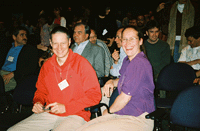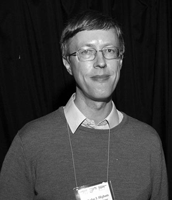Community Reaps Honors, New NSF Initiative Beckons
August 7, 2007

Citing �her fundamental contributions in the field of ergodic theory and dynamical systems,� the Association for Women in Mathematics and SIAM selected Lai-Sang Young of the Courant Institute of Mathematical Sciences to give this year�s AWM�SIAM Sonia Kovalevsky Lecture. Young gave the lecture, titled �Shear-Induced Chaos,� at the 2007 SIAM Conference on Applications of Dynamical Systems. �Her pioneering research,� according to the prize committee, �has had a significant impact in the study of dynamical complexity, strange attractors, and probabilistic laws of chaotic systems.� Elected to the American Academy of Arts and Sciences in 2004 and chosen, also by the AWM, to give the Noether Lecture in 2005, Young is "an inspiration to the entire mathematics community, especially to the women's mathematics community,� the committee said.
Talk of the Society
James Crowley
Interesting honors have been bestowed on several of our members in recent months, some of them at our dynamical systems conference in Snowbird at the end of May. Before passing along a few highlights, I want to alert readers to a brand new U.S. funding initiative, still taking shape as I write (late June).
As part of its 2008 budget request, the National Science Foundation is planning a foundation-wide initiative in an area that should intersect the interests of many SIAM members. Called Cyber-enabled Discovery and Innovation, the program is now being defined by various scientific divisions at NSF, but its general themes can be gleaned from the budget presentation to Congress.
As described in the official NSF documents,
"The FY 2008 request includes $52 million for an important new NSF-wide investment to broaden the nation's capability for innovation by developing a new generation of computationally based concepts and tools to analyze complex, data-rich, and interacting systems derived from discoveries on every front. Cyber-enabled Discovery and Innovation (CDI) aims to explore radically new concepts, approaches, and tools at the intersection of computational and physical or biological worlds to address such challenges."
CDI will be shared by many parts of NSF: The Mathematical and Physical Sciences (MPS) directorate, now under the leadership of Tony Chan, hopes to receive roughly $10 million, with half of that amount expected to go to the Division of Mathematical Sciences. As in the case of many broadly based initiatives, it is anticipated that mathematics will enter into joint projects with other disciplines. The Engineering and the Computer and Information Science and Engineering (CISE) directorates also expect to receive substantial funds ($10 million and $20 million, respectively).
Additional details about the substance of CDI can be surmised from statements in the MPS portion of the budget. The document states, for example, "Modeling, algorithms, software and simulation are essential research components in all MPS disciplines as are virtual computing networks accessing common data bases and analytic tools." The DMS component of CDI will likely focus on algorithms and modeling, much of it motivated by the emerging world of peta-scale computing, where massive data flows and enormous databases pose exceptional challenges.
"CDI is a major new initiative to advance mathematics, science and engineering along fundamentally new pathways opened by high-performance computation, through development and application of models, algorithms, and software," says DMS director Peter March. "The mathematical sciences research community has an important role to play in this area."
While the amounts may seem small for a major initiative, the allocation for 2008 is initial funding that would increase by similar amounts in succeeding years of the initiative. Total funding could exceed $250 million per year after five years.
This is an important new source of funding. Increases in future years hinge on several factors, many of which are outside the control of the scientific community. One important factor does depend on the community, however--the response to the call for proposals. A strong response, in the form of top-quality proposals, can do much to ensure that future increases materialize.
***
Without an Annual Meeting in 2007---SIAM's way of encouraging the community to participate in ICIAM 2007---we moved several events to the program of the SIAM Conference on Applications of Dynamical Systems, held in Snowbird, Utah, May 28 to June 1. Among the rescheduled events was the annual SIAM Business Meeting, an update for members on the state of SIAM. Interested readers will find notes from the meeting on the SIAM Web site.
The dynamical systems community also had the chance to host the annual AWM�SIAM Sonia Kovalevsky Lecture, which highlights significant contributions of women to applied or computational mathematics. Lai-Sang Young, this year's lecturer, was chosen in recognition of her fundamental contributions in the field of ergodic theory and dynamical systems. The Ralph E. Kleinman Prize, also usually awarded at the Annual Meeting, was presented in Snowbird to Salvatore Torquato of Princeton University for his many and deep contributions to the modeling, analysis, and computational study of heterogeneous materials.
The dynamical systems conference was chosen for these events because the conference is so . . . well . . . dynamic. The biennial conference now attracts about 700 participants, from the mathematical sciences and a diverse set of scientific and engineering disciplines, linked by an interest in nonlinear dynamics and their applications. Re-ports on some of the interesting scientific talks at the conference are scheduled for future issues of SIAM News, along with coverage of prizes awarded by SIAG/DS.
I would be remiss not to mention here one of the most enjoyable events of the meeting---a party celebrating the engagement of Hinke Osinga (DSWeb editor) and Bernd Krauskopf (co-chair of the organizing committee for the conference). Congratulations and best wishes to both!

Bernd Krauskopf, co-chair of the Program Committee for the 2007 SIAM Conference on Applications of Dynamical Systems, and Hinke Osinga, editor of DSWeb. Joining Krauskopf on the Program Committee were co-chair Sue Ann Campbell, University of Waterloo; Arjen Doelman, University of Amsterdam; Jinqiao Duan, Illinois Institute of Technology; Alain Goriely, University of Arizona; Aric Hagberg, Los Alamos National Laboratory; Mary Silber, Northwestern University; and Mary Lou Zeeman, University of Texas, San Antonio.
Congratulations are also in order for David Gottlieb, who was elected this spring to the U.S. National Academy of Sciences. That well-deserved honor brings to mind the recent election of Nick Higham, a member of the SIAM Board of Trustees, as a Fellow of the Royal Society. This is always an honor for our field, as well as for the individuals. And Nick is in good company: Among other new fellows named in recent years are Jerry Marsden and Nick Trefethen, both also elected while members of the SIAM Board of Trustees. Hmm. . . .

What do the Royal Society in London and SIAM have in common? Both have placed Nick Higham, Jerry Marsden, and Nick Trefethen in positions of the utmost importance: Higham (shown here) was elected a Fellow of the Royal Society this year, following in the footsteps of Marsden and Trefethen, who were similarly honored last year. All three were at the time of their election (and still are) members of the SIAM Board of Trustees.
On the subject of people in the news, major changes are in the works at the NSF-funded institutes in the mathematical sciences. The older institutes (MSRI, IMA, IPAM), along with MBI, have all sought new directors in recent months. MSRI is the first to have named a new director. Robert Bryant, a professor of mathematics at Duke University, takes the reins on August 1, 2007, succeeding David Eisenbud. (Bryant is also among this year's newly elected members of NAS.)
On the subject of people in the news, major changes are in the works at the NSF-funded institutes in the mathematical sciences. The older institutes (MSRI, IMA, IPAM), along with MBI, have all sought new directors in recent months. MSRI is the first to have named a new director. Robert Bryant, a professor of mathematics at Duke University, takes the reins on August 1, 2007, succeeding David Eisenbud. (Bryant is also among this year's newly elected members of NAS.)
As I write, the Institute for Mathematics and its Applications has just announced the appointment of Fadil Santosa as its next director, effective July 1, 2008. Santosa will replace Doug Arnold, who has run the IMA since 2001. SIAM Review readers will know Santosa as the Survey and Review section editor. He has been at the University of Minnesota for several years, and was deputy director of the IMA from 2001 to 2004. He is also director of the Minnesota Center for Industrial Mathematics.
The search for new directors of IPAM and MBI continues, with the new appointments at both to take effect in the summer of 2008.
In conclusion, I want to mention one item on the agenda for the July meeting of the SIAM Council: the issue of whether SIAM should emulate many other societies by creating a fellows program. In July 2006, the Council appointed a committee to look into the issue; the committee is scheduled to report back to the Council in Zurich, at the July meeting. A weighty issue such as this would be expected to go to the full membership for a vote, if, of course, there is sufficient interest among the Council members.

